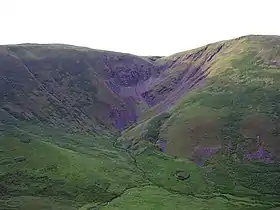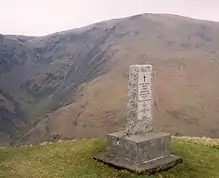Devil's Beef Tub
The Devil's Beef Tub, (Marquis of Annandale's Beef-Tub, Beef-Stand, MacCleran's Loup) is a deep, dramatic hollow in the hills north of the Scottish town of Moffat. The 500-foot (150 m) deep hollow is formed by four hills, Great Hill, Peat Knowe, Annanhead Hill and Ericstane Hill. It is one of the two main sources of the River Annan.

Etymology
The unusual name derives from its use to hide stolen cattle by the Border Reivers of the Johnstone clan who were referred to by their enemies as "devils"; it is also called Marquis of Annandale's Beef-Tub (or Beef-Stand) after the Lord of Annandale, chief of the raiding "loons" (here meaning "lads", rather than "lunatics"); the name may also refer to the resemblance the valley bears to a tub used for preserving meat.[1][2]
History

On 12 August 1685 fleeing covenanter John Hunter attempted to escape pursuing dragoons by running up the steep side of the Beef Tub. He failed, was shot dead on the spot, and is buried in Tweedsmuir kirkyard (churchyard). A monument to Hunter stands on the southwest rim of the Beef Tub.
Literature
In his novel Redgauntlet, novelist Walter Scott said, "It looks as if four hills were laying their heads together, to shut out daylight from the dark hollow space between them. A damned deep, black, blackguard-looking abyss of a hole it is". Scott also describes the flight of a highlander fleeing the aftermath of the failure of the Jacobite rising of 1745; the soldier rolls down the hill amid a hail of enemy gunfire, and escapes. The Beef Tub is also known as MacCleran's Loup after the tumbling highlander.
References
- "A story of the 'Forty Five'". Chambers's Edinburgh Journal. Chambers, Edinburgh (294): 267–268. 16 September 1837. Retrieved 4 March 2012.
- The terms meat tub and beef tub are similar, and discussed at "'Meal - Metheglin', Dictionary of Traded Goods and Commodities, 1550-1820". 2007. Retrieved 4 March 2012.